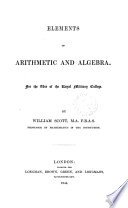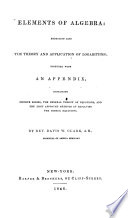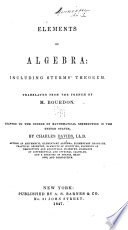 Since the square of a binomial is equal to the square of the first term, plus twice the product of the first term by the second, plus the square of the second ; if... Since the square of a binomial is equal to the square of the first term, plus twice the product of the first term by the second, plus the square of the second ; if...  Elementary Algebra - Page 72by Benedict J. Sestini - 1854 - 136 pagesFull view Elementary Algebra - Page 72by Benedict J. Sestini - 1854 - 136 pagesFull view - About this book
 | Davis Wasgatt Clark - 1844 - 394 pages
...other term (Art. 292). Thus, V^+Zpx 2—x+p, and vV— 2px-\-p2=x— p. 324. We have also seen that the square of a binomial is equal to the square of the first term, plus twice the product of the two terms, plus the square of the last term. Thus, And the square of the residual,... | |
 | William Scott - Algebra - 1844 - 568 pages
...be transposed to the second member ; then x*+px=—q. Since the square of a binomial is composed of the square of the first term, plus the double product of the first term by the second, plus the square of the second term, it follows that x°+px may be regarded as the... | |
 | Charles Davies - Algebra - 1845 - 382 pages
...extracting the 'square root. It has already been shown (Art. 46), that, (o + 6)2 = a2 + 2ab + 62 ; that is, The square of a binomial is equal to the square of the first term plus twice the product of the first term by the second, plus the square of tJie second. • The square of... | |
 | Davis Wasgatt Clark - Algebra - 1846 - 374 pages
...other term (Art. 292). Thus, vV+2px +p 2 —x+p, and Vx'—Zpx+p'=x—p. 324. We have also seen that the square of a binomial is equal to the square of the first term, plus twice the product of the two terms, plus the square of the last term. Thus, Hence, if p2 be added to... | |
 | Algebra - 1847 - 386 pages
...extracting the square root. It has already been shown (Art. 46), that, (a + J)2 = a2 + 2a¿ + b2 ; that is, The square of a binomial is equal to the square of the frst term plus twice the product of the first term by the second, pías the square of the second. The... | |
 | Joseph Ray - Algebra - 1848 - 252 pages
...the principle, by which the first member of this equation may always be made a perfect square. Since the square of a binomial is equal to the square of the first term, plus twice the product of the first term by the second, plus the square of the second ; if we consider x2-{-2px... | |
 | Joseph Ray - Algebra - 1852 - 408 pages
...the principle by which the first member of this equation may always be made a perfect square. Since the square of a binomial is equal to the square of the first term, plus twice the product of the first term by the second, plus the square of the second ; if we consider x^-\-2px... | |
 | Joseph Ray - Algebra - 1848 - 250 pages
...the principle, by which the first member of this equation may always be made a perfect square. Since the square of a binomial is equal to the square of the first term, plus twice the product cf the first term by the second, plus the square of the second ; if we consider x*-\-2px... | |
 | Joseph Ray - Algebra - 1852 - 422 pages
...the principle by which tl a first member of this equation may always be made a perfect square. Since the square of a binomial is equal to the square of the first term, plus twice the product of the first term by the second, plus the square of the second ; if we consider x^-\-2px... | |
 | Joseph Ray - Algebra - 1866 - 252 pages
...explain the principle by which the first member of this equation may always be made a perfect square. The square of a binomial is equal to the square of the first term, plus twice the product of the first term by the second, plus the square of the second. If, now, we consider... | |
| |